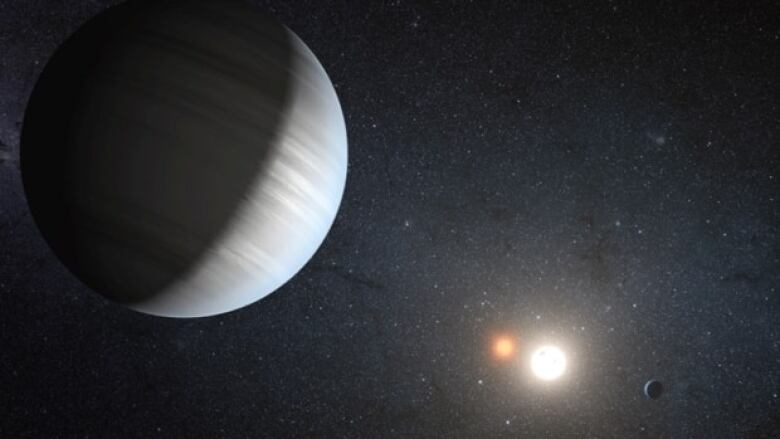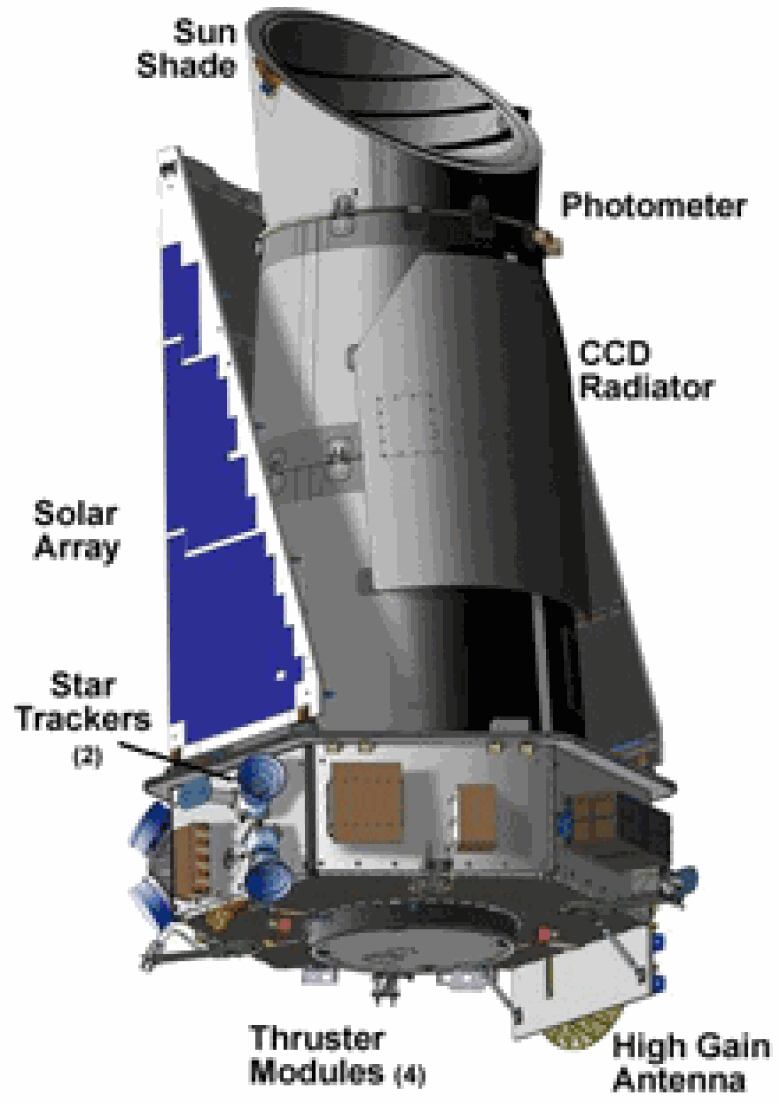Astronomers spot multiplanet system with 2 'suns'
Light data from Kepler telescope suggests at least 2 planets orbiting sun-like body and smaller companion star

Astronomers analyzing data from the Kepler space telescope have found a new planetary system that has at least two planets orbiting a pair of stars, only the fifth example of such a system to have been spotted in theregion of our galaxy being monitored by Kepler.
Kepler-47, as the system has been dubbed, consists of a bright, primary star similar in size to the sun, a smaller companion star about one-thirdthe size and 60 times dimmer than the main star and at least two planets, one that orbits the two stars every 49.5 days and another farther out that circles the stars every 303.2 days.
In the three years that the Kepler telescopehas been hunting for evidence of Earth-size planets orbiting stars other than our sun, many binary stars and even triple-star systems have been seen.
But prior to the recent find, only four binary star systems have been found to containplanets.
"Triple systems are actually fairly common when you have a binary and around that binary is another star but the idea of a planetary outer body has been fairly recent," said astronomer Jerome Orosz of San Diego State University, lead author of a paper on Kepler-47published online Tuesdayinthejournal Science.
Kepler-47 is the only two-star system to date to contain more than one planet, and although the reserachers have confirmed the existence of only two orbiting planets, their analysis suggests there could even be a third.
Planets are probably gas giants
The planets in the Kepler-47 system are likelygas giants,celestial bodieslike Jupiter, Uranusor Saturn thatare composed mainly of gases rather than solid matter.

As a result, they are not habitable although the outer planet is located in what is known as the "habitable zone,"theregion arounda star that lies at a distance at which it is theoretically possible for a planet to maintain liquid water onits surface.
The inner planet has a radius three times largerthan that of Earth. The outer planetis 4.6 times larger than Earth in terms of its radius, and 16 to 23 times heavier.
Their existence in such a binary starsystem shows that planets can form just as easily around two stars as around one large one, likeour own sun, Orosz said.
"The fact that we actually see now planetary systems around binary stars indicates that, in fact, the formation [of planets] basically proceeds on schedule as it does around single stars," he said.
In our solar system,planets formed out of the gas, dust and other material thatpiled up in a rotating ring of matter surrounding the sun called the circumsolar, or circumstellar, disc, and in Kepler-47 and othertwo-star planetary systems,the processwould haveessentially been the same.
"From the point of view of the planets forming in these circumsolar discs, they don't really care, evidently, whether there is a single star or a close binary," Orosz said. "That wasn't an obvious point until we found these systems."
Light fluctuations suggest planet transits
In a system like Kepler-47, the stars themselves are also moving, orbiting the same common centre of mass as the planets, and orbiting each other in the case of Kepler-47, every 7.45 days.

Theybelong to a class of binary stars known as eclipsing binaries.
"These are stars that orbit each other, and their orbits are seen 'edge-on' (i.e., in the same plane)," said Orosz.
"When the orbits are edge-on, the stars can eclipse each other, and when one star blocks the other, that leads to a drop in the brightness, which can be measured."
It was while studying the light fluctuations around binary stars that Orosz and his colleagues spotted evidence of planetary transits around one particular pair of stars.
Atransit occurs when a planet's path crosses that of the star it is orbiting, blockingout some of the light the star emits. For astronomers to spot a transit, the two orbits have to be precisely aligned in the same plane and seen "edge-on" with our or in this case, the Kepler instrument'sline of sight.
Transits occur at regular intervals, depending on the relative lengths of the respective orbital periods of the planet and star, so if astronomers noticethe samedecrease in light emission recurring regularly, they know the dimming is being caused by an orbiting planet rather than some other object randomly crossing the star's orbit.
"The transits really tell you that you have a planetary mass," said Orosz. "There's no other way around it you've got a planet."
For binary systems, transits are harder to spot because the stars themselves are moving, so the planetary crossings are not exactly periodicthe timing of when they occur and how long they take can vary by a number of hours or even days for each subsequent transit.
Multiplanet systems common but hard to see
Multiplanet systems around binary stars are probably quite common, Orosz said, but since transits are currently the only way astronomers have of finding them, very few have been identified.

"For every one of these transiting circumbinary planets we see, there's probably a couple of hundred similar systems that don't actually transit," he said.
Oroszestimates there are likely another five to 10 similar binary planetary systems yet to be uncovered in the data already collected by Kepler.
Finding them will likely require a group effort by the same kind of large, multidisciplinary team that found Kepler-47 and the four other circumbinary systems (known as Kepler-16, -34, -35 and -38, respectively).
"It's a large effort among many individuals," Orosz said of the work it took to find Kepler-47.
"People that make the Kepler telescope work, people that develop the pipelines to analyze the Kepler data people at the McDonaldObservatory in Texas getting ground-based spectroscopy, theorists trying to figure out what's going on, people modelling the dynamics. So, it's just a huge team effort among many people to pull all this together."












_(720p).jpg)


 OFFICIAL HD MUSIC VIDEO.jpg)
.jpg)



























































































